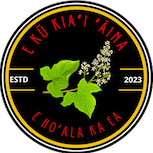
In the Fall of 2005, I was one of sixteen who had been arrested and charged for trespassing. Most of my companions were kūpuna (elderly). We had been assisting an older friend remove debris that land developers had shoveled into her ʻauwai (irrigation ditch) which fed her small taro patch. In the process of our pro se[1] defense, to prove to the court their lack of jurisdiction to convict us, I began a path of discovery about the land laws in the State of Hawaii, and how developers, such as the ones who tried to arrest us, had no rights to the land or court jurisdiction. After days and hours spent in the law library, at the Bureau of Conveyances, and the Hawaii State Archives we were able to mount our defense standing as sovereign citizens under Kingdom Law: the constitution and laws that existed within the Kingdom prior to the “overthrow” of the ʻaupuni o Hawaiʻi (Hawaiian[2] government) in 1893. The result in the court, after six months of arguments, was that the case against us was dropped, probably out of frustration. Court officials did not acknowledge that they had no jurisdiction, but they did agree that we had a right to be on the land.[3] We, as sovereign activists, thought it confirmed our belief that since the State’s existence was based on illegal actions, the State courts had no jurisdication. Our win was the exception, yet we attracted little public attention.
My journey, however, towards becoming a sovereignty advocate had started earlier; in 1967, when I first arrived on the island of Maui at the age of ten. Hawaii had only been a State for eight years. Our rental home was in the town of Kihei, where we could feel the distant bombs being dropped on the military training grounds on the island of Kaho’olawe, shaking our home, disturbing our sleep, and my education. The explosions were constant and unnerving. Plantation workers’ families were only just being moved out of the plantation camps into newly developed unsegregated residential subdivisions in what was to become Kahului. Many of the Kānaka Maoli (Native Hawaiian) families that I had come to know still lived on their ancestral lands.[4] The public schools, like the ones I attended, were only just beginning to de-segregate, and were majority non-white, while private schools were still largely Haole (Euro-American; foreigner).[5] It was in this atmosphere that I first began to witness the discrimination, oppression, and forced Americanization that many Kānaka Maoli lived with daily. At school, I heard my teachers ridicule Kānaka Maoli students for not speaking “good English,” and watched them track the Kānaka Maoli “hard-head” boys into the lowest level classes, sometimes even physically removing them from our upper-level classes. As part of the States’ required Americanization process of recognizing the authority of the American flag, we, as students were all subjected to the required stop at attention when we heard the bugle call before and after school, as well as a complete education in English classics. We learned nothing about the history or culture of Hawaii, except for May Day, the yearly student presentation of music and song. This is why my own exposure to Hawaiian studies consisted only of ʻukulele lessons. It would not be until adulthood, and the start of the “Hawaiian Renaissance,”[6] and the rising tide of Kānaka Maoli activisms, did I learn about the illegal “overthrow” of the Hawaiian Kingdom.[7]
